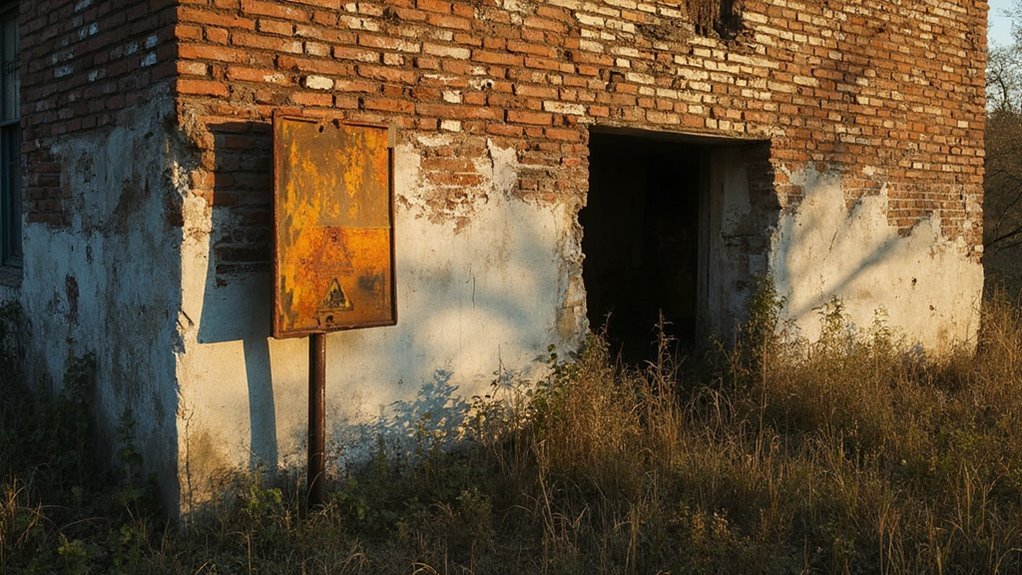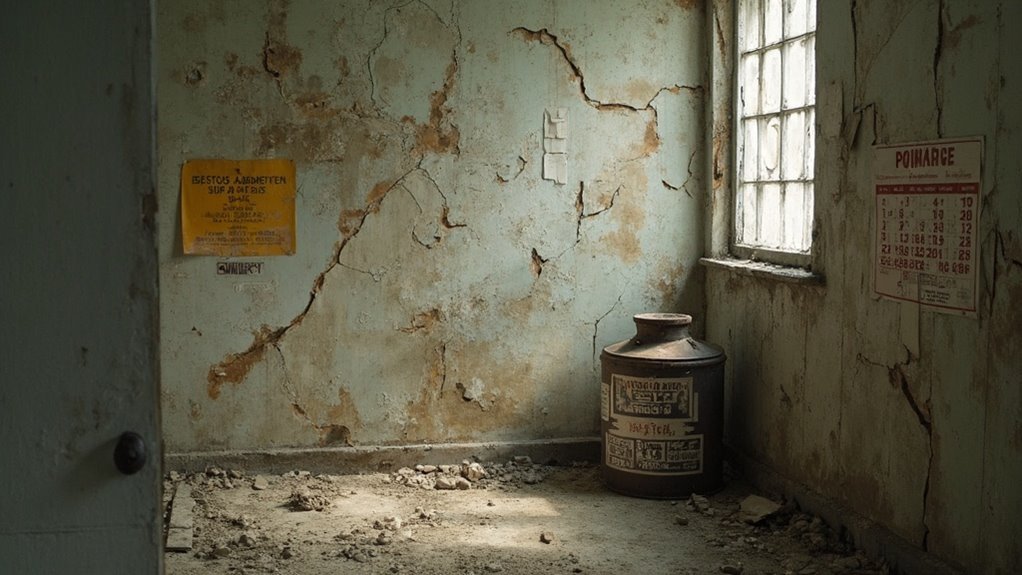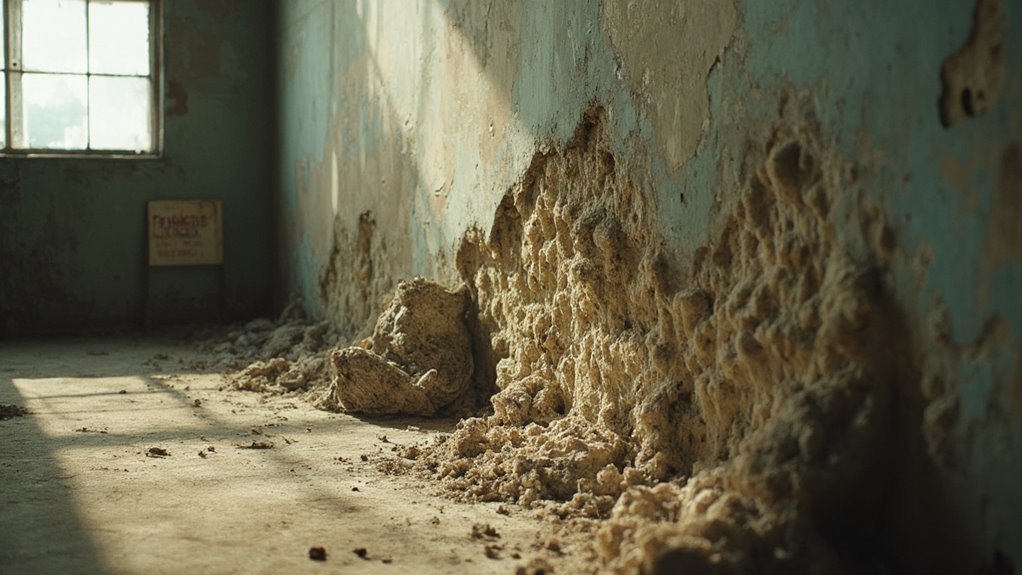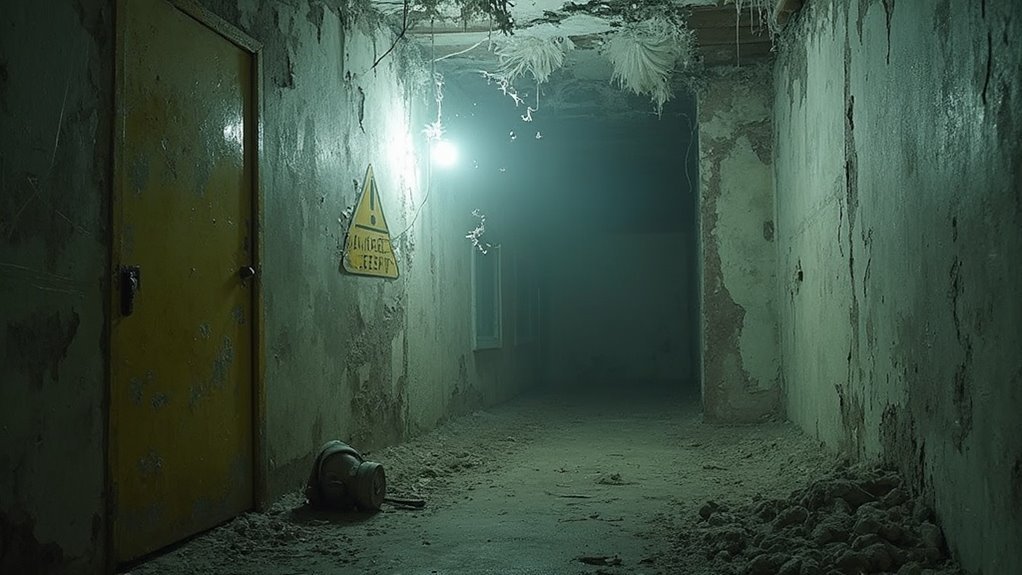Regardless of whether you believe your space is asbestos-free, there are important signs that suggest you may need abatement immediately. The age of your building plays a significant role, as older structures often contain asbestos. Be alert for health symptoms like persistent coughing, shortness of breath, or unexplained weight loss, which can indicate exposure. Regular inspections prior to any renovations are necessary, and identifying damaged asbestos-containing materials (ACMs) is important for safety. Knowing the abatement procedures and regulatory requirements is critical. Understanding these aspects will guide your next steps towards a safer environment.
Age of Your Building

When it comes to the age of your building, many people mistakenly believe that structures built after 1980 are automatically free from asbestos. This misconception can lead to significant renovation risks, as the presence of asbestos can occur in buildings of any age owing to various factors, including imported building materials. The EPA's NESHAP regulation explicitly mandates that an asbestos inspection is required before any renovation or demolition project, regardless of when the building was constructed.
Even newer buildings may contain asbestos in insulation, plasters, or other materials. Relying solely on documentation or assumptions about a building's age doesn't guarantee safety; thorough inspections are vital. It's important to conduct an asbestos survey that covers the entire facility or the areas affected by renovation. Polarizing Light Microscopy (PLM) is the accepted method for analyzing asbestos content, providing reliable results that documentation cannot. Follow-up testing often reveals ACM in post-1980 buildings, highlighting the importance of comprehensive inspections. Additionally, health risks of asbestos exposure can develop years later, making proactive inspections crucial for safety.
Homeowners and tenants should remain vigilant about potential asbestos hazards, as neglecting inspections can lead to non-compliance and unintended exposure. By understanding the significance of inspections, you can effectively manage asbestos risks in your renovation projects.
Health Symptoms to Watch
When it comes to asbestos exposure, you should be vigilant about any respiratory issues that may arise. Symptoms can often be delayed, so recognizing persistent signs like a cough or shortness of breath is essential. Early identification of these health effects can greatly influence treatment options and overall outcomes. Regular inspections for potential health risks can help you catch any issues before they escalate.
Respiratory Issues Manifest
Asbestos exposure can lead to a variety of respiratory issues that manifest through specific health symptoms. You should be vigilant for signs like a persistent cough, shortness of breath, or chest tightness. These symptoms may indicate underlying conditions such as asbestosis, lung cancer, or mesothelioma. For instance, if you experience a dry cough accompanied by crackling sounds during breathing, it could signal asbestosis. Moreover, coughing up blood or unexplained weight loss might suggest lung cancer, while chest pain and fatigue are common in mesothelioma.
Engaging in regular respiratory assessments is crucial for early detection of these issues. Keep a detailed record of your symptoms through symptom tracking, noting any changes or escalations. This information can be invaluable for healthcare professionals when evaluating your exposure history and recommending appropriate diagnostic tests, such as lung function tests and chest X-rays. Being proactive about your respiratory health can greatly improve outcomes, especially if you've been exposed to asbestos. Don't hesitate to discuss your concerns with a medical professional, as timely intervention can lead to better treatment options and improved quality of life.
Delayed Health Effects
The delayed health effects of asbestos exposure can be insidious, often taking years or even decades to surface. You may not notice symptoms until 15 to 50 years after your initial exposure, making health monitoring significant. Diseases such as asbestosis, lung cancer, and mesothelioma develop slowly, and early signs might be mistaken for other conditions.
It's fundamental to watch for the following indicators:
- Persistent dry cough or chest tightness
- Shortness of breath, especially during routine activities
- Unexplained weight loss and fatigue
Asbestosis can lead to a gradual buildup of scar-like tissue in your lungs, impairing both lung and heart function. Lung cancer symptoms may include coughing up blood and respiratory complications, while mesothelioma might present with abdominal swelling. The latency period of these diseases complicates diagnosis, as you might not connect current symptoms to previous asbestos exposure. As a result, regular health monitoring and a detailed medical history are important for identifying potential issues early. If you notice any of these symptoms, don't hesitate to consult a healthcare professional for further evaluation.
Recognizing Persistent Symptoms
Recognizing persistent symptoms related to asbestos exposure is vital for early detection and intervention. If you notice shortness of breath or a persistent dry cough, these could be significant asbestos symptoms. Chest tightness or pain may indicate respiratory complications, requiring immediate attention.
Weight loss from a reduced appetite can signal advanced asbestos-related diseases, while dry, crackling sounds in your lungs during breathing suggest lung damage. Coughing up blood is a serious symptom linked to lung cancer caused by asbestos exposure, and abdominal swelling could indicate peritoneal mesothelioma.
Chest pain and tightness often accompany pleural mesothelioma and asbestosis, and fatigue paired with shortness of breath is common in mesothelioma. Furthermore, watch for clubbing of fingers, which can be a sign of asbestosis.
Early detection is vital; seek medical help if you notice these symptoms. Regular screening, including low-dose CT scans, can identify potential issues, while detailed job history and exposure information assist in accurate diagnosis. By monitoring your health closely, you increase the likelihood of effective treatment and improved outcomes for asbestos-related conditions.
Importance of Inspections

Regular inspections play an important role in identifying asbestos-containing materials (ACMs) and evaluating their condition to prevent harmful exposure. These inspections are significant, as asbestos exposure can lead to serious health issues such as lung scarring, mesothelioma, and lung cancer. Since asbestos can't be identified by sight alone, a professional assessment is necessary to guarantee safety.
To maintain a safe environment, consider the following key points:
- Building Age: Older structures typically have a higher likelihood of containing ACMs, warranting more frequent inspections.
- Material Condition: Damaged or deteriorating ACMs require closer monitoring and potentially more regular surveys.
- Renovation Needs: Before any refurbishment or demolition, thorough inspections are fundamental to assess potential risks.
Establishing a consistent inspection frequency is important for compliance with regulations and to manage ACMs safely. By engaging certified inspectors, you can confirm that any ACMs are located and quantified appropriately, allowing for well-informed choices regarding their management. Regular assessments not only comply with legal obligations but likewise protect the health of occupants, making inspections a non-negotiable aspect of property maintenance.
Understanding Abatement Procedures
After identifying asbestos-containing materials (ACMs) during inspections, it's vital to understand the subsequent abatement procedures aimed at safely removing these hazardous materials. The process begins with a licensed inspector conducting a thorough evaluation, which includes sending suspicious samples for laboratory analysis. This guarantees all ACMs are properly identified to create an effective removal plan.
Once the assessment is complete, preparation of the work area is critical. The table below outlines the key steps:
| Preparation Steps | Purpose |
|---|---|
| Seal off area with polyethylene | Prevent contamination |
| Disable HVAC systems | Stop fiber spread |
| Set up decontamination areas | Guarantee safe entry/exit |
During abatement, contractors employ various methods, including wet techniques to minimize dust release. After removal, thorough cleaning is performed using high-efficiency particulate air (HEPA) vacuums. Finally, an independent inspection checks for airborne fibers, guaranteeing compliance with safety protocols. Only after successful clearance testing can the area be re-occupied, confirming that all asbestos hazards are effectively managed.
Environmental Impact of Asbestos

As you consider the environmental impact of asbestos, it's vital to understand how it affects ecosystem health. Contamination can lead to long-term environmental effects, disrupting habitats and reducing biodiversity. Implementing effective contamination mitigation strategies is fundamental to protect both the environment and public health.
Asbestos and Ecosystem Health
Thousands of communities worldwide face the environmental impacts of asbestos, which can severely disrupt ecosystems. The presence of asbestos in air, soil, and water not only poses health risks to humans but likewise threatens biodiversity and ecosystem resilience. When asbestos fibers contaminate natural habitats, they can hinder plant growth and impair aquatic life.
- Asbestos contamination can reduce species diversity, leading to a less balanced ecosystem.
- Contaminated water sources affect both terrestrial and aquatic organisms, disrupting food chains.
- Soil pollution from asbestos can alter nutrient cycles, further impacting ecosystem health.
You might not realize that former asbestos mining sites can leach contaminants into surrounding areas, exacerbating the problem. Wind and water can carry these toxic fibers into local environments, creating widespread contamination. As an active member of your community, understanding these risks is essential. The long-term persistence of asbestos in ecosystems poses a significant challenge for conservation efforts and biodiversity protection. By recognizing the signs of asbestos pollution, you can advocate for measures that support ecosystem resilience and protect both human health and environmental integrity.
Contamination Mitigation Strategies
Understanding the environmental impact of asbestos is fundamental for developing effective contamination mitigation strategies. First, you need to improve your asbestos awareness by recognizing areas where asbestos might be present. Conduct a thorough risk assessment to identify potential hazards, focusing on undamaged asbestos materials that may require sealing or encapsulation to prevent fiber release.
During removal activities, employ safe practices by using wet methods to minimize dust and restricting access to authorized personnel only. It's critical to utilize HEPA-filtered vacuums for cleaning to eliminate any circulating fibers effectively.
Always engage trained and accredited asbestos professionals for removal, applying a wetting agent to keep fibers contained. Dispose of any asbestos waste securely in sealed, leak-proof plastic bags to prevent contamination.
After abatement, guarantee extensive post-abatement procedures are in place. This includes testing the area for residual fibers and obtaining written assurance from contractors that all safety protocols have been followed. Documenting every step of the process is fundamental for compliance and future reference. By implementing these strategies, you can notably mitigate the risks associated with asbestos contamination in your environment.
Long-term Environmental Effects
The long-term environmental effects of asbestos contamination pose significant challenges that extend beyond immediate health risks. Asbestos has a remarkable environmental persistence, remaining in soil, air, and water for decades because of its non-biodegradable nature. This means that once asbestos fibers are released into the environment, they can travel far from their source and continue to pose risks long after initial exposure.
- Asbestos fibers can become airborne, increasing the likelihood of inhalation and health complications.
- Disturbance of asbestos-contaminated sites, such as during construction or landscaping, can worsen the spread of harmful fibers.
- Soil contamination often leads to long-term risks, particularly when contaminated soil is reused without proper management strategies.
Understanding the asbestos lifecycle is vital for implementing effective abatement measures. The persistence of asbestos in the environment necessitates rigorous regulatory compliance and thorough site investigations to identify contamination sources. Without addressing these long-term environmental effects, communities may experience compounded health risks, as even minimal exposure can be harmful. Awareness and proactive management are critical to mitigate the ongoing impact of asbestos in our environment.
Regulatory Compliance Requirements
Adhering to regulatory compliance requirements for asbestos abatement is crucial for any project involving asbestos-containing materials (ACM). You must navigate various regulatory frameworks, including federal, state, and local regulations, to guarantee safety standards are met. The National Emission Standards for Hazardous Air Pollutants (NESHAP) outlines specific work practices for asbestos during renovations and demolitions, mandating notifications to state agencies when certain thresholds of ACM are involved.
Both OSHA and EPA set forth requirements for training and safety protection at job sites. For instance, the EPA's Model Accreditation Plan (MAP) necessitates that asbestos professionals in schools and commercial buildings obtain proper accreditation. States may impose additional training requirements, and many require companies to hold relevant licenses for asbestos abatement.
It's equally critical to be aware of local regulations, such as those in New York City, where notifications must be submitted to the Department of Environmental Protection at least seven days prior to work. Confirming compliance with these regulatory requirements protects not only your project but likewise the health and safety of everyone involved.
Finding Professional Help

When tackling an asbestos abatement project, finding the right professionals is vital to guarantee safety and compliance with regulations. You'll want to ascertain your chosen contractor possesses the necessary qualifications and expertise to handle asbestos removal effectively.
Consider the following key factors when selecting a contractor:
- Certifications: Verify they're certified in asbestos removal, demonstrating their understanding of proper removal techniques and safety protocols.
- Experience: Look for contractors with a proven track record in similar projects. Request references and examples of previous work to assess their qualifications.
- Insurance: Confirm that they have liability insurance specifically covering asbestos-related tasks, protecting you from potential liabilities.
A qualified contractor will conduct a thorough assessment of your property, employ specialized containment measures, and utilize appropriate personal protective equipment (PPE). Their expertise guarantees compliance with local, state, and federal regulations, which is fundamental for safe, effective removal. By investing time in finding the right professional, you can safeguard yourself and others from the dangers of asbestos exposure during the abatement process.
Frequently Asked Questions
How Long Does Asbestos Removal Typically Take?
Asbestos removal typically takes one to five days, depending on the amount and accessibility of the material. The removal process involves safety measures and thorough cleanup to guarantee air quality meets safety standards.
Can I Remove Asbestos Myself?
You shouldn't attempt DIY asbestos removal. Use proper asbestos identification methods to assess risks. DIY asbestos precautions often fail to guarantee safety, making professional abatement the best option to avoid exposure and legal issues.
What Should I Do if I Suspect Asbestos?
If you suspect asbestos, like in a home renovation, prioritize safety. Arrange for asbestos testing by certified professionals to assess health risks. Avoid disturbing materials and guarantee proper containment during any necessary abatement procedures.
How Much Does Professional Abatement Cost?
Professional abatement costs typically range from $1,192 to $3,255, averaging around $2,215. Factors like location, type, and amount of asbestos greatly influence these costs for necessary professional services in remediation efforts.
Are There Alternatives to Asbestos Removal?
Yes, there are asbestos alternatives like encapsulation and enclosure, which use safe materials to seal or isolate asbestos. These methods can be less disruptive and cost-effective, but require regular inspections and professional assessments for long-term safety.
